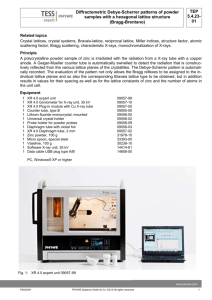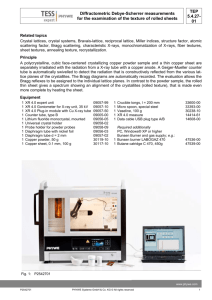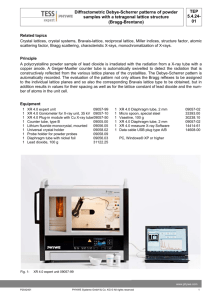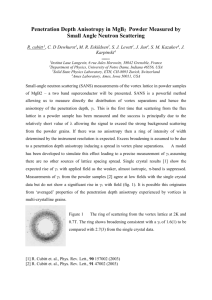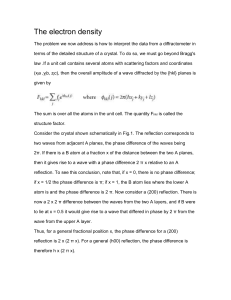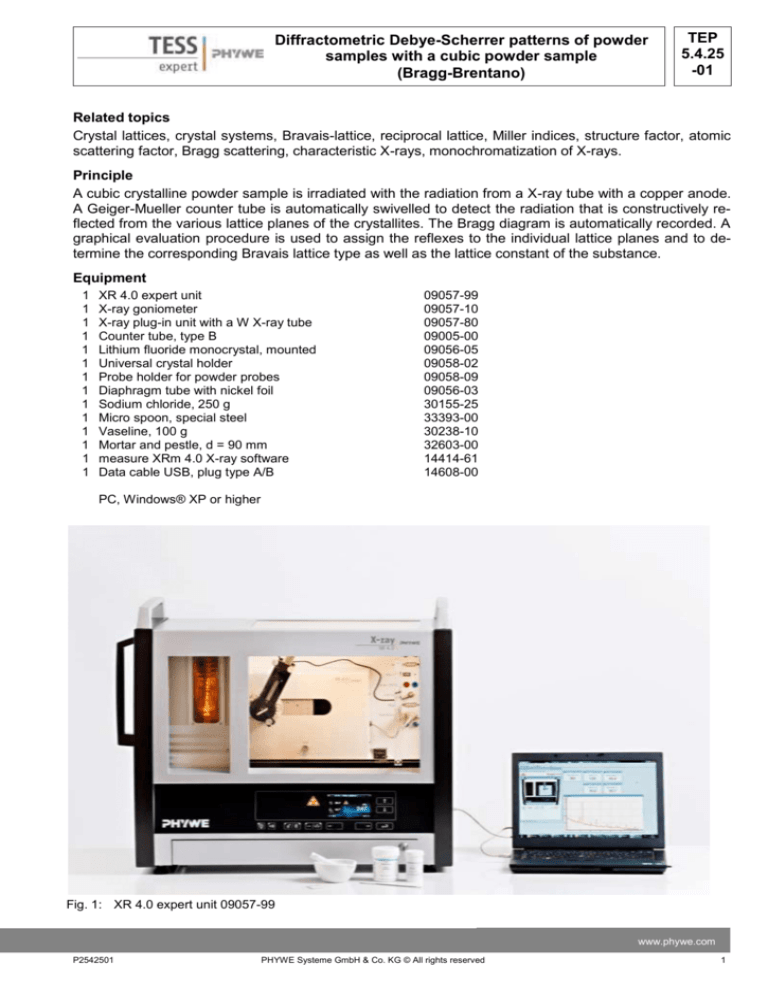
Diffractometric Debye-Scherrer patterns of powder
samples with a cubic powder sample
(Bragg-Brentano)
TEP
5.4.25
-01
Related topics
Crystal lattices, crystal systems, Bravais-lattice, reciprocal lattice, Miller indices, structure factor, atomic
scattering factor, Bragg scattering, characteristic X-rays, monochromatization of X-rays.
Principle
A cubic crystalline powder sample is irradiated with the radiation from a X-ray tube with a copper anode.
A Geiger-Mueller counter tube is automatically swivelled to detect the radiation that is constructively reflected from the various lattice planes of the crystallites. The Bragg diagram is automatically recorded. A
graphical evaluation procedure is used to assign the reflexes to the individual lattice planes and to determine the corresponding Bravais lattice type as well as the lattice constant of the substance.
Equipment
1
1
1
1
1
1
1
1
1
1
1
1
1
1
XR 4.0 expert unit
X-ray goniometer
X-ray plug-in unit with a W X-ray tube
Counter tube, type B
Lithium fluoride monocrystal, mounted
Universal crystal holder
Probe holder for powder probes
Diaphragm tube with nickel foil
Sodium chloride, 250 g
Micro spoon, special steel
Vaseline, 100 g
Mortar and pestle, d = 90 mm
measure XRm 4.0 X-ray software
Data cable USB, plug type A/B
09057-99
09057-10
09057-80
09005-00
09056-05
09058-02
09058-09
09056-03
30155-25
33393-00
30238-10
32603-00
14414-61
14608-00
PC, Windows® XP or higher
Fig. 1: XR 4.0 expert unit 09057-99
www.phywe.com
P2542501
PHYWE Systeme GmbH & Co. KG © All rights reserved
1
TEP
5.4.25
-01
Diffractometric Debye-Scherrer patterns of powder
samples with a cubic powder sample
(Bragg-Brentano)
Tasks
1. Record the intensity of the Cu X-rays back scattered by a cubic powder sample as a function of the back scattering angle.
2. Assign the Bragg reflexes to the respective lattice planes. Determine which Bravais lattice type it has.
3. Calculate the number of atoms in the unit cell.
Set-up
Connect the goniometer and the Geiger-Müller counter tube to
their respective sockets in the experiment chamber (see the red
markings in Fig. 2). The goniometer block with the analyser crystal
should be located at the end position on the left-hand side. Fasten
the Geiger-Müller counter tube with its holder to the back stop of
the guide rails. Do not forget to install the diaphragm in front of the
counter tube.
Insert a diaphragm tube with a diameter of 2 mm into the beam
outlet of the tube plug-in unit.
Note
Details concerning the operation of the X-ray unit and goniometer Fig. 2: Connectors in the experiment
as well as information on how to handle the monocrystals can be chamber
found in the respective operating instructions.
Holder for Powder
samples and universal crystal holder
Counter
tube diaphragm
GM-counter
tube
diaphragm tube
d = 2 mm
Goniometer at the
left end position
Fig. 3: Set-up of the goniometer
2
PHYWE Systeme GmbH & Co. KG © All rights reserved
P2542501
Diffractometric Debye-Scherrer patterns of powder
samples with a cubic powder sample
(Bragg-Brentano)
TEP
5.4.25
-01
Procedure
- Connect the X-ray unit via the USB cable to the
USB port of your computer (the correct port of
the X-ray unit is marked in Figure 4).
- Start the “measure” program. A virtual X-ray unit
will be displayed on the screen.
- You can control the X-ray unit by clicking the
various features on and under the virtual X-ray
Fig. 4: Connection of the computer
unit. Alternatively, you can also change the parameters at the real X-ray unit. The program will
automatically adopt the settings.
- Click the experiment chamber (see the red
marking in Figure 5) to change the parameters
for the experiment. Select the parameters as
shown in the text box.
- If you click the X-ray tube (see the red marking
in Figure 5), you can change the voltage and
current of the X-ray tube. Select the parameters
as shown in the text box: Anode voltage UA = 35
kV; anode current IA = 1 mA..
- Start the measurement by clicking the red circle:
-
After the measurement, the following window
appears:
For setting the
X-ray tube
For setting the
goniometer
Fig. 5: Part of the user interface of the software
-
-
Select the first item and confirm by clicking OK.
The measured values will now be transferred
directly to the “measure” software.
At the end of this manual, you will find a brief
introduction to the evaluation of the resulting
spectra.
Note
- Never expose the Geiger-Müller counter tube
to the primary X-radiation for an extended period of time.
Overview of the settings of the goniometer and
X-ray unit:
- 1:2 coupling mode
- angle step width 0.1°
- Scanning range 10°-45°
- Anode voltage UA = 35 kV; anode current
IA = 1 mA
- Scanning speed, when only the very intense
reflex lines are to be recorded, then scanning can be relatively rapid at 10 s/°. For the
identification of weaker lines, a scanning
speed of at least 30 s/° is required for a better signal/noise ratio
www.phywe.com
P2542501
PHYWE Systeme GmbH & Co. KG © All rights reserved
3
TEP
5.4.25
-01
Diffractometric Debye-Scherrer patterns of powder
samples with a cubic powder sample
(Bragg-Brentano)
Sample preparation
The sample must be so finely powdered that no grains can be felt when a little of it is rubbed between
finger and thumb. A relatively high sample concentration can be obtained by mixing the powder with a little vaseline. To do this, transfer a small amount of the sample onto a sheet of paper and use a spatula to
knead it to a firm paste. To achieve the highest concentration of material as possible, use very little vaseline (a spatula tip of it). Fill the relatively solid sample paste into the specimen for powder samples and
smooth it flush. Use the universal crystal holder to hold the specimen.
Calibration of the goniometer with the LiF single-crystal:
Exact angular positions of Debye-Scherrer reflections are only to be expected when the goniometer is
correctly adjusted. Should the goniometer be out of adjustment for any reason whatever, this fault can be
corrected either manually or by means of the autocalibration function:
- Automatic calibration:
The anode material of the X-ray tube is automatically identified. The crystal must be manually set under “Menu”, “Goniometer”, “Parameter”. For calibration, select “Menu”, “Goniometer”, “Autocalibration”. The device now determines the optimal positions of the crystal and the goniometer to each other
and then the positions of the peaks. The display shows the corresponding calibration curves. The
newly configurated zero position of the goniometer system is saved even after switch-off of the X-ray
unit.
- Manual calibration
The crystal for analysis must be manually brought to the theoretical Bragg angle ϑ (counter tube correspondingly to 2ϑ). Now search for the intensity maximum of the line by iterative turning of the crystal
and counter tube by a few ±1/10° around this angular position. Following this and in coupled mode,
bring the crystal and counter tube to the particular zero position corrected by the error value and then
confirm with “Menu”, “Goniometer” and “Set to zero”.
Theory and Evaluation
When X-rays of wavelength λ strike a mass of lattice planes of a crystal of spacing d at a glancing angle
of ϑ, then the reflected rays will only be subject to constructive interference when Bragg’s condition is fulfilled, i.e.:
2d sin n (n = 1, 2, 3, ...)
(1)
Bragg’s condition implies that all of the waves scattered at the atom are in phase and so amplify each
other, whereas partial waves that are scattered in directions not fulfilling Bragg’s conditions are of opposite phase and so extinguish each other. A more realistic way of looking at this must, however, take the
actual phase relationships of all of the partial waves scattered by the atom in a certain direction into consideration. When there are N atoms in a unit cell, then the total amplitude of the X-rays scattered by the
cell is described by the structure factor F, which is the sum of the atomic scattering factors f of the individual N atoms, taking their phases into account.
In general, the following is valid for F:
N
Fhkl f n e 2i hun kvn hwn
(2)
1
where h, k, l = Miller indices of the reflecting lattice planes and un, vn, wn are the coordinates of the atoms
in fractions of the particular edge lengths of the unit cell.
As F is in general a complex number, the total scattered intensity is described by |Fhkl|2.
A cubic simple unit cell contains only one atom with the coordinates 000. From equation (2), therefore,
the structure factor for this lattice type is given by:
4
PHYWE Systeme GmbH & Co. KG © All rights reserved
P2542501
Diffractometric Debye-Scherrer patterns of powder
samples with a cubic powder sample
(Bragg-Brentano)
F f e 2i 0 f ; F
2
f
2
TEP
5.4.25
-01
(3)
This means that F2 is independent of h, k and l and all Bragg reflexes can occur.
The unit cell of a cubic face-centered lattice has 4 atoms at 000, ½ ½ 0, ½ 0 ½ and 0 ½ ½. The unit cell of
a cubic body-centered lattice has in comparison only 2 atoms at 000 and ½ ½ ½.
Should the lattice only consist of one sort of atom, then the following conditions are given for the structure factor:
fcc Latice
|F|2 = 16 f2
with h k l only even or only odd
|F|2 = 0
with h k l mixed
(4)
bcc Latice
|F|2 = 4 f2
with (h + k + l) even
2
|F| = 0
with (h + k + l) odd
The situation is a little different when a lattice is constructed of different sorts of atoms.
Should, for example, an fcc lattice contain the atoms A and B, whereby the A atoms are at 000, ½ ½ 0,
½ 0 ½ and 0 ½ ½, and the B atoms at ½ ½ ½, 0 0 ½, 0 ½ 0 and ½ 0 0, then the following conditions are
given for structure factor F:
fcc Lattice with atoms A and B:
|F|2 = 16 (fA + fB)2
2
|F| = 16 (fA - fB)
with (h + k + l) even
2
with (h + k + l) odd
(5)
When, in such an fcc lattice, the atomic scattering factor f is almost the same for each sort of atom
(fA ≈ fB), then a 111 reflex for example will only occur weakly, if at all.
For the cubic crystal system, the spacing d of the individual lattice planes with the indices (h k l) is obtained from the quadratic form:
1
1
2 h 2 k 2 l 2 (a = lattice constant)
2
d hkl a
(6)
From this and equation (1) with n = 1, the quadratic Bragg equation is obtained:
sin 2
2
4a
2
h
2
k2 l2
(7)
The following so-called strip-matching procedure can be used to index the individual reflexes of cubic
crystals. Take logarithms in equation (7):
1
lg a lg lg
2
h
2
k 2 l 2 lg sin
(8)
Plot the experimentally determined values for lg (sinϑ) on a strip of paper. In addition, plot the 2nd term
www.phywe.com
P2542501
PHYWE Systeme GmbH & Co. KG © All rights reserved
5
TEP
5.4.25
-01
Diffractometric Debye-Scherrer patterns of powder
samples with a cubic powder sample
(Bragg-Brentano)
on the right hand side of equation (8) on a separate strip of paper, taking all possible index triplets into
consideration.
1
lg lg
2
h
2
k2 l2
(9)
Now move the scales against each other until a position is found at which the graduations on the two
strips match up to a great extent. The distance between the zero points of the two strips now gives the
value of lg(a): Taking anti-logs gives the lattice constant a of the cubic system.
↑ ↑
1
2
3
4
5
6
7
8
9
↓
↓
↓
↓
↓
↓
↓
Fig. 6: Bragg-Cu-Kα and Cu-Kβ-lines of NaCl
6
PHYWE Systeme GmbH & Co. KG © All rights reserved
P2542501
Diffractometric Debye-Scherrer patterns of powder
samples with a cubic powder sample
(Bragg-Brentano)
Task 1: Record the intensity of the Cu X-rays
back scattered by a cubic powder sample as a
function of the back scattering angle.
Fig. 6 shows the Debye-Scherrer spectrum of
sodium chloride (NaCl).
As no filter is used for the monochromatization
of the X-rays, when individual lines are evaluated consideration must be given to the fact
that the very intense lines that result from Kαradiation are accompanied by secondary lines
that result from the weaker Kβ radiation.
These pairs of lines can be identified by
means of equation (1). It is namely approximately true with λ (Kα) = 154.18 pm and λ (Kβ)
= 139.22 pm that:
TEP
5.4.25
-01
↑
2
K sin 154,18 pm
1,1
K sin 139,22 pm
4
6
↓
↓
(10)
These values correspond with the quotients of
the sinq values (Fig. 6) of the pairs of lines 21, 4-3 and 6-5, which shows that the lines 1, 3,
5 and 7 originate from the Cu Kβ radiation.
The correctness of this conclusion can be Fig. 7: Bragg-diagram of NaCl only with Cu-Kα beam (a
nickel filter was used here)
shown by a control measurement using the diaphragm tube with nickel foil to reduce the intensity of the Kβ radiation (see Fig. 7). The reflexes in Fig. 2 that were previously assigned to the Kβ lines have now disappeared. As the intensity of
the Kα- radiation is also somewhat weakened by the Ni foil, the detection of reflexes of weak intensity at
larger glancing angles is made difficult when this is used.
Task 2: Assign the Bragg reflexes to the respective lattice planes. Determine which Bravais lattice type it
has.
For reasons of clarity, it is assumed as a limitation in the following that NaCl does not form a simple unit
cell, but rather an fcc or bcc lattice. Table 1 lists all of the possible index triplets possible in this case, i.e
only non-mixed h,k,l combinations, or such for which (h + k + l) = 2n is true, were considered. The
wavelength λ (Kα) = 154.18 pm was used to calculate values from equation (9).
Table 1: Permissible h,k,l index triplets for fcc and bcc lattices.
hkl
h2+k2+l2
111
200
112
022
013
113
222
3
4
6
8
10
11
12
lg h 2 k 2 l 2 lg
2,126
2,188
2,276
2,339
2,387
2,408
2,427
1
2
hkl
h2+k2+l2
213
004
1 1 4/0 3 3
313
024
323
224
14
16
18
19
20
22
24
lg h 2 k 2 l 2 lg
1
2
2,460
2,489
2,515
2,526
2,538
2,558
2,577
For the determination of the reflex angle from Fig. 6, zooming on the corresponding angle region and ac-
www.phywe.com
P2542501
PHYWE Systeme GmbH & Co. KG © All rights reserved
7
TEP
5.4.25
-01
Diffractometric Debye-Scherrer patterns of powder
samples with a cubic powder sample
(Bragg-Brentano)
curate determination of the main part of the line to
two decimal places is recommended
Table 2 lists the glancing angles of the Kα- radiation
reflexes determined from Fig. 6, as well as the corresponding sin values and lg(sin) values.
Table 2: Glancing angles of the NaCl reflexes from
Fig. 6.
Line
2
4
6
7
8
9
ϑ/°
15,89
22,79
28,30
33,25
37,70
42,05
sin ϑ
0,2738
0,3874
0,4741
0,5483
0,6115
0,6698
lg (sin ϑ)
-0,5626
-0,4119
-0,3241
-0,2610
-0,2136
-0,1741
To obtain satisfactory accuracy from the graphical
evaluation, the two scales should preferably be prepared as shown in Fig.8, equal but expanded.
The coincidence of the two scales shows that no
mixed indexed triplets occur, but only even numbered h,k,l values.
Lattice constant a is determined from the logarithm
of the difference in the zero points of the two scales. Fig. 8: Evaluation of the NaCl reflex lines using the
stripmatching procedure
As Fig. 8 shows, the two sclaes coincide at the values 2.30 and -0.45, i.e. the difference is 2.75. Taking the anti-log of 2.75, a = 562.3 pm is obtained for the lattice constant (literature value; a = 563.0 pm).
It can be shown that the unit must be “pm“ by an example, using equation (1) to calculate the lattice
plane spacing d of any of the reflexes in Fig. 6.
Task 3: Calculate the number of atoms in the unit cell.
As only even numbered h,k,l values occur, it would seem that NaCl forms a cubic body-centered crystal
lattice with 2 atoms per unit cell. This statement can be checked as follows. On dividing the total mass M
of a unit cell by its volume V, the density ρ is given, so that:
m
N a3
M
1
n m 3 mit m A n
V
N
mA
a
(11)
where n = the number of atoms or molecules in the unit cell; m = atomic/molecular mass; mA = atomic/molecular weight; N = 6.022 · 1023 = Avogadro’s number.
Entering known values for NaCl (ρ = 2.164 g·cm-3 and mA = 58.44 g) in equation (11), n = 3.96 ≈ 4 is obtained, i.e. according to this, the unit NaCl cell contains not 2 but 4 atoms. This would mean that NaCl
forms an fcc lattice. This contradiction to the above results can be clarified by returning to the considerations made with equation (4).
Considering the fact that the atomic scattering factor f correlates linearly with the number of electrons of
an atom, among others, and that Na (Z = 11) and Cl (Z = 17) have nearly the same scattering power, it
follows from equation (5) that reflexes with odd numbered h,k,l triplets can only occur very weakly, if at
all.The NaCl results of n = 4 and (h + k + l) = 2n can only be brought into agreement with an fcc lattice
type.
8
PHYWE Systeme GmbH & Co. KG © All rights reserved
P2542501


